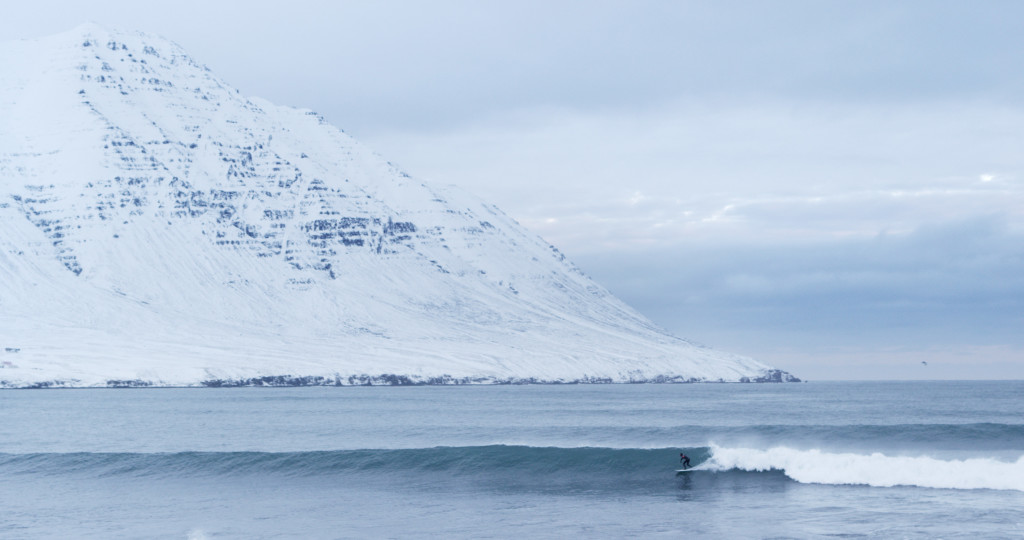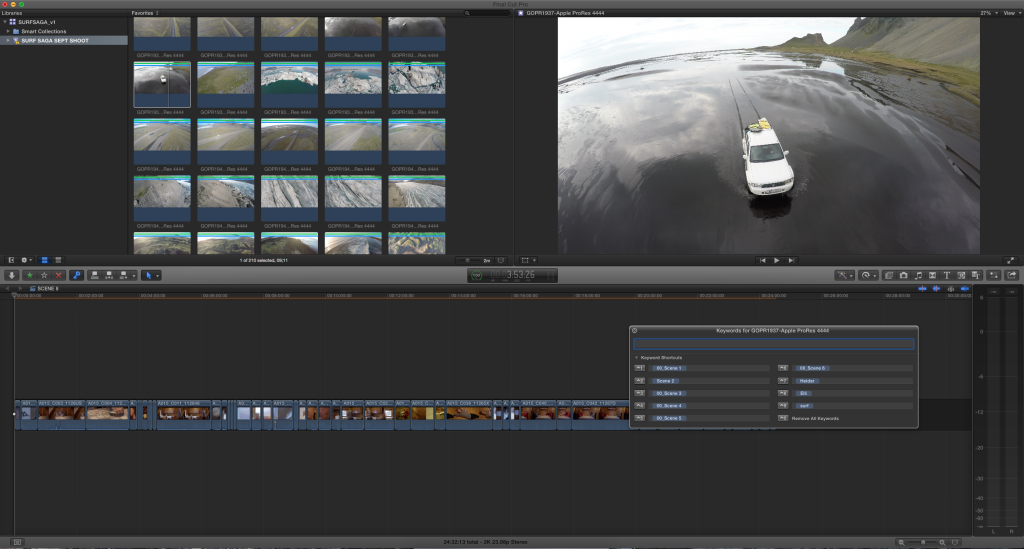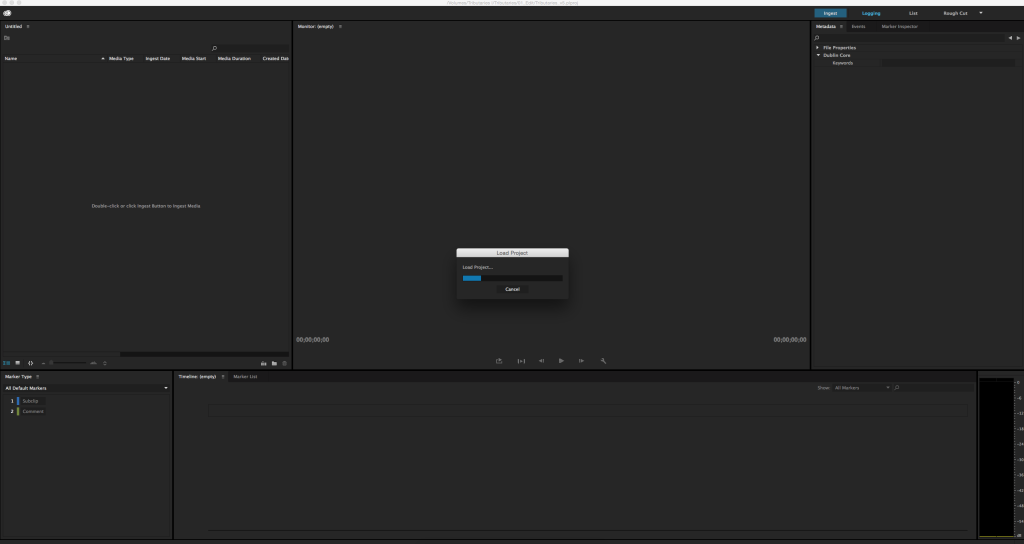A New Frankenstein-ed Editing Process
The only thing that matters is what works in post-production.

Now that we’re on our 4th film, we’ve come to a good understanding of the common bottle-necks and issues faced in the cutting room when working on our outdoor documentaries. There is a ridiculous amount of footage when shooting these things! And more often than not, there isn’t a script to cut from. So walking out of production into post, there was always this ominous feeling of having a LARGE elephant in the room (namely TB’s on TB’s of raw footage on hard drives).
Even though we’re a small team, we like to have our footage logged. It’s crucial to have access to every fish that’s caught or every select surf shot that exists on our drives – it makes editing an actual pleasure instead of always digging. Also, simply watching footage surfaces those tiny moments that you might miss or forget where they are. As far as we’re concerned: Logging is the answer!
Therein lies the problem: I have yet to see a great logging system. We’ve seen production houses use spreadsheets, we’ve seen (and we’re very unenthused by) the native logging system in FCP7, we’ve even cut two of our films using the uber-clunky Adobe Prelude, and we’ll talk more about that in a minute, but, if logging is the answer, why doesn’t the boss of logging software exist?
Oh Prelude. You were a good attempt at solving our problem but you didn’t quite make it. First, a positive: Prelude can work with ALL type of footage – From our RED (.R3D files), our FS700 files (AVCHD), our DSLR’s and GoPro’s files (MP4’s) – importing into Prelude without having to convert anything is actually a pleasure. But this is where the convenience ends, abruptly. First, you have no idea what keywords you used to log your footage. So, let’s say you come back a year later and forgot what exact keywords you used – it quickly becomes a guessing game. Which is just the same as randomly opening folders and looking through footage. It’s not a great way to surface the best footage.
Another fatal flaw, you can only search for one keyword at a time. For example, if you wanted to find all the great surf selects of Frank – Prelude can’t process searching for the two keywords: “frank” and “surf”, you’d get no results. For a keyword based logging software, you’d think this is the first thing they’d get right.
Lastly, Prelude is SLOOOOWWW. On a big project, it takes literally 10 minutes for it to start working and loading. There’s more wrong with Prelude, but these three things make prelude impossible to use and we couldn’t be happier to experiment with other solutions.

Key-wording, easily accessible favorites, and if you’ll notice the timeline is our selects for “Scene 8” – these are all great advantages to using FCPX as a logging tool.
Enter Final Cut Pro X. Although this is an extra $300 on top of our already spendy Adobe subscription, we feel it’s well worth it. We can easily import all of our footage and it comes in automatically tagged with our DIT file naming conventions, for example we use [Date]_[Location]_[General Activity]_[Camera]_[Card #] in the way we dump files. This is the core of our DIT strategy during production and the fact that FCPX imports this information automatically is an incredible thing.
Command + K is the keyword tool in FCPX. Add as many as you want and never get disorganized – it’s actually a pretty amazing system. Not only do all your keywords show in your left side panel, you can filter all your footage by keywords you’d like to see. For example, you can filter all clips that have the keywords “Frank” and “Surf” and there you have it – Frank is Surfing!
Our other love for FCPX is our ability to skim through footage. What I’ll generally do, is skim through a clip. Decide if it’s worthy, if it is – I’ll press “F” making it a favorite in FCPX to be found later (another great feature). Then, I’ll go through all my favorites and categorize them into Frank’s and Surfing’s and whatever else needs to be organized. Another great use for the skim is, I recently had a screenshare call with a client and was able to quickly skim through ALL the footage so that they could get a general idea of what we had in the can. Easy and simple. One downside to FCPX is we need to convert all AVCHD, DSLR and GoPro footage to Pro Res. It’s not the end of the world, and we’ve made it work just fine but it’s a small annoyance.
Although we’re impressed with FCPX as a logging tool, we never want to actually edit in that program again! It might be because we’re curmudgeons and we’re simply used to the FCP7/Premiere timeline and finishing tools but, creatively and technically, FCPX simply doesn’t hold up to a proper edit. Overall, our work looks way better going through Premiere than it ever has coming out of FCPX. The decision was easy, don’t use FCPX as an editing tool, keep it as logging software.
Workflow between the two is, admittedly, clunky. Here’s the best way we’ve learned so far: Let’s say you want all those selects of Frank surfing. Drag all those favorites into a new timeline. Export the timeline as an XML, use the program XtoCC to convert that XML and then open in Premiere. It’s a roundabout way of getting footage places but once it’s in Premiere you’re ready to go. Also, we find ourselves doing a lot of “Reveal in Finder” in FCPX and dragging that file directly into Premiere. Again it’s round-about but it’s working. We feel the time it takes get footage to Premiere makes up for the time it takes to actually find the footage.
Ka-Boom! A new way to log and surface our best footage. This process is constantly evolving but we’re happy with the way it’s headed. We wish Adobe would put the proper time into it’s Prelude program so we can just use our subscription to log footage, but until then we’ll frankenstein a proper workflow that works for us.
Stay tuned over the next month or two for our upcoming Icelandic surf film, The Accord,





Write a Comment